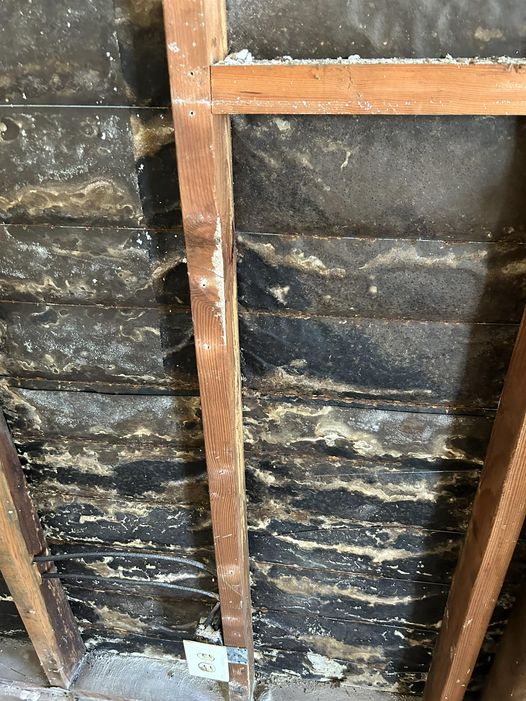Any tips on preventing water seepage through stucco walls in a 1950s house and repairing damaged tar paper from the inside?
10 months ago
Last Updated: August 19, 2024
So, I’ve got this house from the 1950s and I’m wondering how water manages to seep through the stucco walls and what’s up with the weird tar paper situation. Any thoughts on how to fix this mess from the inside? Thanks in advance!

I can’t give you a clear answer except that there should be wood sheathing over your wood stud framing. In older homes, this would have been strips of 1×6 or 1×8 installed at an angle over the stud framing. With advancements in technology, this would be replaced by plywood or nowadays osb sheathing. There should be a barrier layer like roofing felt over the sheathing and then mesh and the stucco plaster itself. It seems like your house is lacking sheathing. I would consider that a problem.
Moisture getting in will always be fixed from the outside. Whether you caulk and paint, or replace siding, trim, drip edges, etc. You’re not solving it from the inside.
If the vapor barrier wasn’t up to par, there’s a chance that humidity from inside moved to the outer wall and condensed. Depending on how the stucco was installed, there might be moisture from rain seeping in behind it. In the past, stucco application using cedar lath allowed air to circulate and dry the wall wrap out. However, newer stucco systems hinder this drying process, leading to wall sheeting deterioration. Modern wall cladding and siding systems create a space that keeps outside moisture at bay and allows for proper drying.
Mentioned the same thing. I agree with this assessment.
‘s post is spot on. When cold outside stucco meets warm indoor air, condensation can occur. To prevent this, ensure there is a proper vapor barrier with a small gap between it and the stucco. Increasing the R-value will help retain indoor heat and prevent warming of the stucco. This should address any issues, unless there are outside leaks.
The issue arises when modern heating systems are installed in older homes. These new systems introduce cold air makeup to the cold air return, causing a pressurization effect in these leaky, drafty structures. This pressure forces moisture outward, leading to condensation on the underside of the exterior cladding or stucco. In contrast, older heating systems in buildings often operated at a negative pressure, where combustion air drew up the chimney and minimal makeup air was pulled from the interior. The fresh air makeup system brought dry air from outside, which was then heated and further reduced the air’s Relative Humidity.
Nail penetrations that can’t be fixed from the inside.
Make sure to strip away as much as possible. Recently, builders are applying a water barrier that resembles white glue on the concrete before adding plaster and paint. I recommend asking Whitecap about the substance and dilution ratio, as water can easily pass through concrete. Nowadays, they are also placing a plastic vapor barrier on the gravel before pouring slabs and cleats to prevent water from seeping in from below.
You could opt for professional installation of two-part foam. It typically comes in 50-gallon drums and requires a special machine for mixing. ‘t forget the special personal protective equipment (PPE) needed. Once that’s done, you can start by putting back the interior wall and then move on to repairing the most cracked parts outside.
Swap out the tar paper for Tyvek.
I came across an article about spray foam earlier today that discussed issues like sweating and wood rot.
They utilized it on the external wall of the tall building I constructed. If you still live there, you’ll need to close up the walls from the inside first. Or you could set up a tent, strip it down to the frame, address the exterior issue, and then work on the interior once it’s dry.
On the high rise, there was fiberglass drywall and a rubberized coating that resembled concrete/grout. However, it was soft enough to be cut with a utility knife if it overflowed into the electrical boxes.
Check the vapor barrier, roof, and so on.
The window is leaking. We’ll need to address this from the outside. Do you know if this is the south or west wall? I’m asking because most storms come from that direction. Make sure to inspect the caulking around all stucco penetrations, like the wood trim around the windows.
I’m considering using this method for the exterior renovation, what do you think?
https://m.youtube.com/watch?v=YXQaWw0tNe8&pp=ygUXemlwIHN5c3RlbSBsaXF1aWQgZmxhc2g%3D
Although it’s quite pricey.
Keep in mind that stucco is porous!
Have you ever wondered why tyvek is used in new construction?
Could you add some more tar to it?
Here’s the link to the video: https://youtu.be/N-X4_mbwP5I?si=igaW31MYAFFJPZrg
https://thecraftsmanblog.com/the-pitfalls-of-old-home-insulation/
Could it be that insulation is contributing to the issue, preventing the walls from breathing properly?
Yes
I don’t have a lot of guidance to offer, but here are some thoughts that come to mind that could assist you in your exploration and decision-making process…. stucco that has been consistently exposed to rainwater over many years will start to deteriorate and lose its strength.. opening up a portion of the tar paper might provide you with the information you need.. are the studs decaying.. a cold wall that hasn’t been adequately insulated and lacks a vapor barrier will become completely soaked in cold weather due to indoor humidity.. In older homes, condensation in the attic has seeped under the roof and made its way into the stucco on exterior walls… Is your problem occurring in the summer, winter, or both.